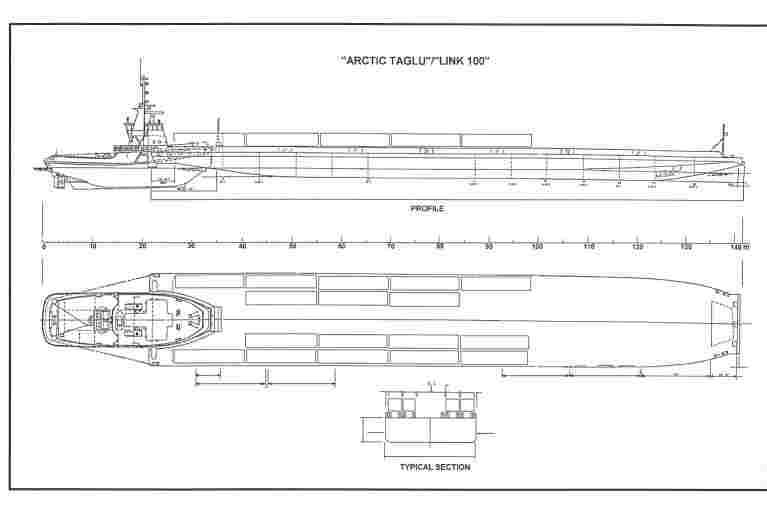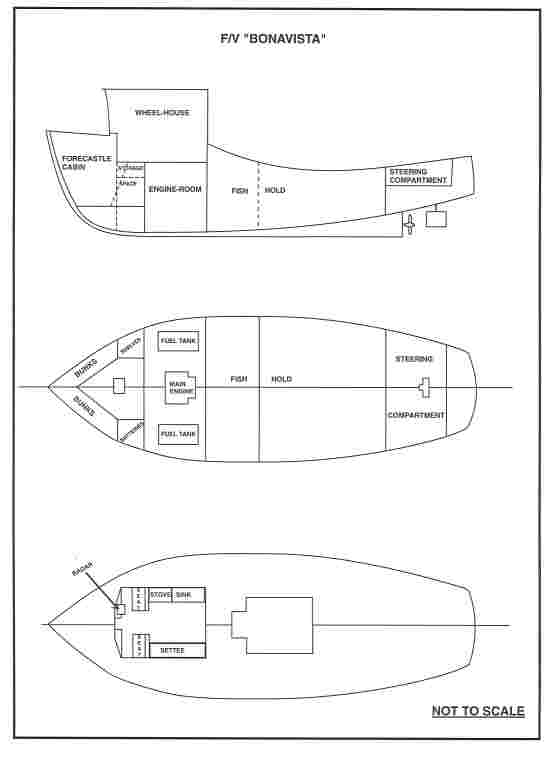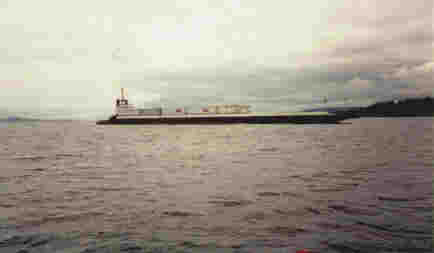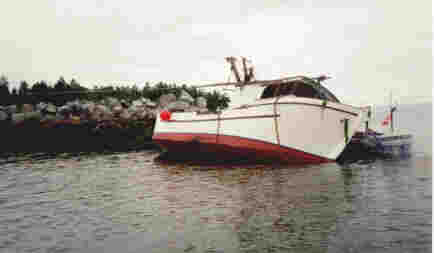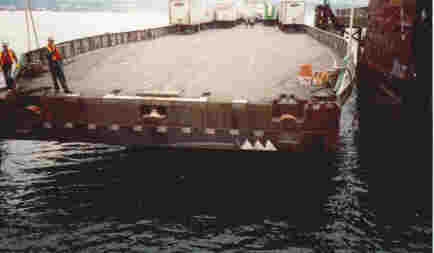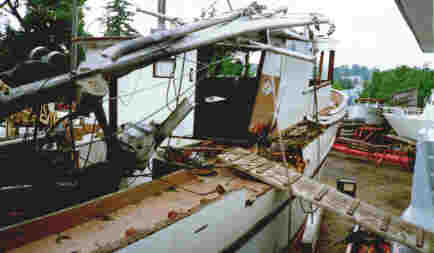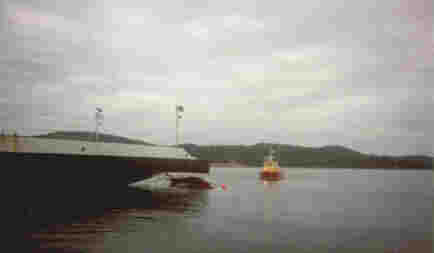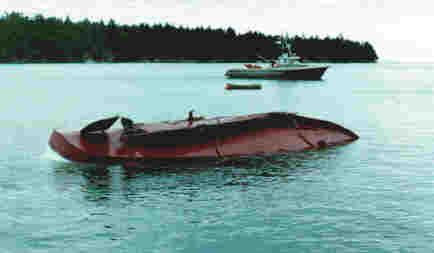Collision
between the tug-barge unit
"ARCTIC TAGLU"/"LINK 100" and
the fishing vessel "BONA VISTA"
Strait of Georgia, British Columbia
The Transportation Safety Board of Canada (TSB) investigated this occurrence for the purpose of advancing transportation safety. It is not the function of the Board to assign fault or determine civil or criminal liability. This report is not created for use in the context of legal, disciplinary or other proceedings. See Ownership and use of content. Masculine pronouns and position titles may be used to signify all genders to comply with the Canadian Transportation Accident Investigation and Safety Board Act (S.C. 1989, c. 3).
Summary
On passage from Vancouver to Swartz Bay, British Columbia, in the early hours of 21 July 1993, the tug-barge unit "ARCTIC TAGLU"/"LINK 100" collided with the northbound fishing vessel "BONA VISTA" off Gossip Shoals, in the eastern approaches to Active Pass. Visibility was good and the weather was calm. The "BONA VISTA" was rolled over by the impact but remained afloat in a capsized condition. The six occupants of the fishing vessel who were trapped inside the overturned hull died as a result of the accident. The fishing vessel was extensively damaged and declared a constructive total loss; the barge suffered minor scratches.
The Board determined that the "ARCTIC TAGLU"/"LINK 100" and the "BONA VISTA" collided because neither took appropriate collision avoidance action, and the "BONA VISTA" inexplicably crossed ahead of the "ARCTIC TAGLU"/"LINK 100".
1.0 Factual Information
1.1 Particulars of the Vessels
| Name of vessel | "ARCTIC TAGLU" | "LINK 100" | "BONA VISTA" |
|---|---|---|---|
| Official number | 368381 | 810465 | 13K42915 |
| Port of registry | Edmonton, Alberta | Vancouver, B.C.Note de bas de page 1 | Prince Rupert, B.C. |
| Flag | Canadian | Canadian | Canadian |
| Type | Pusher tug | Barge | Fishing vessel |
| Gross TonsNote de bas de page 2 | 394 | 2,240 | 14 |
| Length | 31.1 m | 111.25 m | 12.5 m |
| Breadth | 10.39 m | 17.98 m | 3.5 m |
| Draught (approximate) | 4.0 m | 2.0 m | 1.0 m |
| Crew | 4 | unmanned | - |
| Guest | - | - | 5 |
| Built | 1976, North Vancouver, B.C. | 1957, Portland, U.S.A. | 1968, Pender Harbour, B.C. |
| Propulsion | Two diesel engines capable of total 2,250 BHP, driving twin fixed-pitch propellers in Kort nozzles | non-self-propelled | 250 BHP diesel engine driving a single fixed-pitch propeller |
| Owners | Sealink Marine Services, New Westminster, B.C. | Sealink Marine Services, New Westminster, B.C. | Henryk Kajat, Vancouver, B.C. |
1.2 Description of the Vessels
"ARCTIC TAGLU"
The "ARCTIC TAGLU" is a coastal tug which can be used in the pushing mode, having been constructed with a flat‑nosed, pusher bow. The navigation bridge has an open layout with wide windows giving an unobstructed view in every direction. There are four conning positions in the wheel-house: one on the centre line forward, one on each side and one aft facing the vessel's stern.
"LINK 100"
The "LINK 100" is a flat‑topped barge designed to carry deck cargo in the form of roll‑on/roll‑off trailers on a service between dedicated terminals at Vancouver and Vancouver Island, B.C. The barge is fitted with two directional thrusters forward which are controlled from the wheel-house of the tug. A 13 m notch, within which the
"ARCTIC TAGLU" fits, was constructed at the stern of the barge, allowing the tug and the barge to operate as a unit. Two hydraulic connections position the tug in the notch, and a system of blocks, wires, and winches secures the tug to arrest any relative swing between the two vessels. Information gathered during the course of the investigation suggested that the combination is capable of a service speed of 11 knots, but no documentation was located concerning the unit's manoeuvring characteristics.
"BONA VISTA"
The "BONA VISTA" was originally built as a troller/gillnetter fishing vessel but that type of fishing gear was not on the vessel at the time of the occurrence. Recently, the "BONA VISTA" had been employed to store and transport seafood harvested by diving. The vessel was of wooden construction; the 25 mm-thick bottom skin consisted of two layers of 12.5 mm plywood sheeting, and the sides comprised two layers of 10 mm plywood. The hull was divided fore and aft into four sections:
- forward cabin with three bunks and a storage closet;
- wheel-house with the engine compartment below;
- fish hold abaft amidships, the largest compartment; and
- a small steering gear compartment aft.
The wheel-house and forward compartment were interconnected.
The fish hold was insulated with a thick layer of foam sprayed between the frames and sealed with a coating of fibreglass.
1.3 History of the Voyages
"ARCTIC TAGLU""LINK 100"
The tug-barge unit "ARCTIC TAGLU"/"LINK 100", after sailing from the port of Vancouver at approximately 231Note de bas de page 3 5 on 20 July 1993, initially followed the traffic separation scheme routeing as the unit proceeded in a southerly direction toward Active Pass. The passage was routine and the steering was by autopilot. When the tug-barge unit was some three miles north of the Gossip Shoals light buoy, the mate, who was officer of the watch (OOW), reported to the Vessel Traffic Centre (VTC) in Vancouver and was advised that, with regard to opposing traffic exiting Active Pass, two northbound vessels were approaching Gossip Shoals. The fish packer "TYEE NO. 1" was the leading vessel, followed by an unidentified fishing vessel which was reportedly not displaying a green sidelight. Shortly after this exchange, the "TYEE NO. 1" called the VTC at about 0230 to advise that the unidentified fishing vessel had no sidelights and was showing a reddish masthead light and bow lights.
The OOW of the "ARCTIC TAGLU" acknowledged to the VTC that he had heard the description of the lights. When the described lights were sighted, the OOW could not determine the heading of the unidentified vessel from the lights. The OOW altered course a further 5E to starboard in addition to the 5E alteration he had previously made to give the "TYEE NO. 1" more sea‑room. As the vessels continued to close, the OOW shone the beam of a searchlight along the port side of the trailers on the deck of the barge to show the other vessel the size of the barge. The OOW switched the steering from automatic to manual and, when he realized that the unidentified vessel was going to cross ahead of the tug-barge unit, he put the main propulsion to full astern and the steering hard over to starboard. These measures could not prevent a collision, and the "BONA VISTA", which had apparently altered course to port in front of the barge, was rolled over and capsized as the vessels came together. The tug-barge unit came to a stop shortly thereafter and was slowly moving astern when the overturned fishing vessel was located off the starboard side of the barge, forward of amidships. The OOW called and advised the VTC immediately after the collision, at about 0243. This resulted in other vessels coming to the scene to assist in the efforts to rescue the occupants of the "BONA VISTA" who were trapped in the overturned hull.
"BONA VISTA"
The operator of the "BONA VISTA" was the owner of the vessel and he had taken five guests, all relatives, on an excursion to the west coast of Vancouver Island. The vessel had left Vancouver on the evening of 14 July 1993, and called at various points in British Columbia: Victoria, Tofino, some sites in Clayoquot Sound, and was reported to have been secured in Ucluelet Harbour, B.C., on the evening of 19 July, with the intention of staying there overnight. The vessel's presence in Active Pass in the early hours of 21 July would be consistent with a morning departure from Ucluelet on 20 July.
At approximately 0145, 21 July, the "BONA VISTA" was being overtaken by the "TYEE NO. 1" in Swanson Channel, as both vessels approached Active Pass. Intending to leave the as yet unidentified "BONA VISTA" to port, the "TYEE NO. 1" played a spotlight on the "BONA VISTA" which complied with the perceived request by altering course slightly to port. No further action by the "TYEE NO. 1" was required and she overtook the "BONA VISTA". Both vessels transited Active Pass without incident. There was no radio contact between the two vessels. Both vessels continued on northerly courses after clearing the pass. The "TYEE NO. 1" which had drawn about one and one-quarter miles ahead of the "BONA VISTA" when she heard the report of the collision returned to the scene to assist.
1.4 Injuries to Persons
"ARCTIC TAGLU"/"LINK 100"
The collision caused no injuries on the tug-barge unit.
"BONA VISTA"
All six persons who were on board the fishing vessel died as a result of the collision. The six were trapped in the overturned vessel and, although voices and pounding noises had been heard through the hull, all were unconscious when brought out, the last victim being recovered three and a half hours following the accident; resuscitation attempts were not successful. The last person died in hospital on 24 July 1993.
1.5 Damage
"ARCTIC TAGLU""LINK 100"
The tug-barge unit suffered virtually no damage, only minor scratches at the point of impact.
"BONA VISTA"
The fishing vessel was extensively damaged and declared a constructive total loss. Significant structural damage was described in a 23 July surveyor's report as follows:
- keel broken away (from hull) and folded to port;
- propeller (blade) forced through bottom of hull;
- wheel-house/cabin displaced to port;
- starboard bulwark fractured (amidships);
- starboard after coaming broken away;
- hull holed at the chine amidships (starboard side); and
- hull stove in near deck on starboard side.
1.5.1 Environmental Damage
No environmental damage was caused by the collision. The diesel oil released by the overturned fishing vessel quickly dissipated.
1.6 Vessel Certification
"ARCTIC TAGLU""LINK 100"
Certificates of registry had been issued for each vessel.
The "ARCTIC TAGLU" had also been issued a Ship Safety Inspection Certificate (SIC 17) for the tug to operate as a non‑passenger ship on voyages not beyond Home Trade Class III limits. The certificate stipulated that the "ARCTIC TAGLU" could operate as a Home Trade Class III shift boat restricted to the Strait of Georgia and adjacent waters, with a minimum crew of four to comply with the hours of rest of the Safe Manning Regulations. The "ARCTIC TAGLU" is manned alternately by two crews who nominally work five days on and nine days off, no week‑end departures from Vancouver being scheduled.
Because the barge "LINK 100" was unmanned and not carrying a cargo of petroleum products, she was not required to have a Safety Inspection Certificate.
None of these certificates specifically addressed the tug and barge operating in combination as a unit. The two vessels had operated as a unit since 1988.
"BONA VISTA"
Being of less than 15 gross registered tons (GRT), the fishing vessel was not required to be inspected and did not have a Safety Inspection Certificate.
1.7 Personnel Information
"ARCTIC TAGLU""LINK 100"
The master held a Master Mariner Certificate of Competency issued in 1982. He was a part-time instructor at a nautical college, teaching Marine Emergency Duties (MED) courses.
The master had been sailing on the "ARCTIC TAGLU"/"LINK 100" since the tug-barge unit began operations in 1988, for the first year as mate and for the last four years as master. Before this employment, he had sailed, since 1959, as mate and master on various tugs, ice-breakers, ferries and fishing vessels, mostly on the British Columbia coast and in the Canadian Arctic.
The OOW held a Certificate of Competency as a Master Home Trade Steamship of under 350 tons gross tonnage, issued in 1969, with an endorsement for a Ferry Steamship operating between Vancouver and North Vancouver (Short Run) issued in 1977. He had sailed as mate on the "ARCTIC TAGLU"/"LINK 100" tug-barge unit for the previous two and a half years, before which he had been master of a short‑run ferry in Vancouver Harbour for about 12 years.
The OOW had not taken a Simulated Electronic Navigation (SEN) course or an Automatic Radar Plotting Aid (ARPA) course but had attended a radar simulation course prior to being master on the Vancouver Harbour ferry in 1977.
The other two members of the crew of the "ARCTIC TAGLU" consisted of an engineer and a deck‑hand.
Royal Canadian Mounted Police (RCMP) officers boarded the tug-barge unit at about 0800 on 21 July. The crew did not show any sign of impairment. No test for drugs or alcohol was conducted.
"BONA VISTA"
The operator did not hold any marine certificate and none was required to operate the "BONA VISTA". He had not taken any marine navigation courses.
He had eight years of experience as a diver and operator of small boats. For the last four years, he had been employed in the seafood harvesting industry in British Columbia waters. While so employed, he had acquired some watchkeeping and navigation experience. He had become the sole owner and operator of the "BONA VISTA" in February 1992.
Autopsies performed on the six victims revealed no pre‑existing condition which could have adversely affected the victims' performance or ability to survive.
1.8 Weather and Tidal Information
1.8.1 Weather
Both the "ARCTIC TAGLU" and the "TYEE NO. 1" reported that the south-westerly wind was light, the sea was calm and the visibility was good at approximately 10 miles.
1.8.2 Tide and Current
The Canadian Hydrographic Service (CHS) Tide and Current Tables give the times and heights of the tide for the morning of 21 July 1993 at Whaler Bay, on Galiano Island, B.C., inside Gossip Shoals, as being:
- Low water at 0141, height 2.59 m above chart datum.
- High water at 0703, height 3.66 m above chart datum.
The same publication shows that the tidal stream in Active Pass turned to the flood at 0120 and would reach a maximum rate of 2.6 knots on the flood at 0340. Consistent with the small range of the tide and the low rate expected for the maximum flood, the CHS Current Atlas for the Strait of Georgia indicates that the tidal stream at the site at the time of the collision would have been setting generally northerly at a rate of less than one knot.
1.9 Radio Communications
Relevant radio communications before the collision involved three parties: the "ARCTIC TAGLU", the "TYEE NO. 1" and the Vancouver VTC. There was no direct ship‑to‑ship communication before the collision; all communication was through the shore station. There is no record of any call originating from or being addressed to the "BONA VISTA" during this time. The "ARCTIC TAGLU" and the "TYEE NO. 1" were participating in the Vancouver Vessel Traffic Services (VTS) system. The "BONA VISTA", being less than 20 m in length, was not required to participate in the VTS system and was not participating. The gist of the exchanges between the stations was traffic reports, with information also being passed on regarding the apparent lack of sidelights on the "BONA VISTA".
1.10 Vancouver Vessel Traffic Centre (VTC)
In addition to providing traffic services, the VTC tracks, by radar, participating vessels and, at the discretion of the marine traffic regulator (MTR), vessels which are not taking part in the VTS system. The "BONA VISTA" was being tracked at the time of the collision. The VTS tracker records the position of all "tagged" targets at a predetermined interval; in this case, the targets were tracked at an interval of approximately five minutes. Despite the relatively long interval and the fact that the collision occurred in the fourth minute of the tracking cycle, the VTC records helped to confirm and augment the limited information available regarding the vessels' movements before the collision. The geographical positions of the "ARCTIC TAGLU""LINK 100", the "BONA VISTA", and the "TYEE NO. 1" were recorded at 0217:53, 0222:56, 0228:11, 0233:14, 0238:18, and 0243:20.
The targets of the tug-barge unit and the "BONA VISTA" merged at approximately 0242:30.
1.11 Vessel Movements Before the Collision
A reconstruction of the events leading to the collision was facilitated by the information available in the VTC tracking records. At 0233:14, about nine minutes before the collision, the "ARCTIC TAGLU""LINK 100" and the "BONA VISTA" were 2.69 miles apart. The fishing vessel was in Active Pass and on a course somewhat east of north to exit the pass with the "TYEE NO. 1", which had overtaken her, about three-quarter of a mile ahead on a similar heading. The tug-barge unit was about one to two points on the fishing vessel's port bow, heading in toward the pass. At that time, the tug-barge unit was steering to make good a course of about 160E with the Georgina Point light fine on the starboard bow, three miles distant, and the "TYEE NO. 1", also fine on the starboard bow, two and a half miles off and crossing from starboard to port. The "BONA VISTA" was on a relatively steady bearing of about 177E, somewhat less than two points on the starboard bow of the tug-barge unit. At about this time, the OOW on the "ARCTIC TAGLU" altered course some 5E to starboard to give the "TYEE NO. 1" a wider berth, and this is reflected in the course made good to the next recorded position, at 0238:18.
At 0238:18, the tug-barge unit and the fishing vessel had closed to 1.1 miles apart, with the "BONA VISTA" on a course of about 010E and having averaged a speed of about 9.5 knots over the tracked period. The "ARCTIC TAGLU"/"LINK 100" was 15E on the fishing vessel's port bow. At that time, the OOW on the "ARCTIC TAGLU" had altered approximately 5E more to starboard in an attempt to avert a close‑quarters situation with the "BONA VISTA". The bearing of the "BONA VISTA" was now 176E, about half a point on the starboard bow, and slowly drawing ahead. The "TYEE NO. 1" was more than four points on the port bow of the tug-barge unit and seven cables distant. The tug-barge unit had averaged 10.5 knots over the tracked period.
Other information was recorded after the time of the collision. Therefore, it does not significantly contribute to a reconstruction of events leading to the accident, but the evidence indicated that the "BONA VISTA" subsequently crossed ahead of the tug-barge unit before apparently altering course hard to port back across the track of the tug-barge unit (see Appendix C).
1.12 Angle of Impact
The damage to the "BONA VISTA" and the scratches on the forward part of the barge were consistent with the evidence that the tug-barge unit struck the fishing vessel broadside on her starboard side, at right angles. The "BONA VISTA" was rolled over to port, overridden and submerged by the barge, and then surfaced, overturned, alongside the "LINK 100".
1.13 Navigation Practices
"ARCTIC TAGLU"
The master and the mate shared the navigation of the tug-barge unit and, as the unit was on a regular run, a routine had evolved. The master would unberth the tug-barge unit and take the unit out of Vancouver Harbour through First Narrows, B.C., before handing the conduct over to the mate in the vicinity of "QB" buoy. The master would then retire to his cabin, one flight of stairs below the wheel‑house, while the mate was in charge of the navigation to a point about one mile from Active Pass, where the master again took over. The person in charge of the navigation was required to carry out the duties of navigator, look‑out and helmsman, although the "ARCTIC TAGLU" was fitted with an autopilot.
On the night of the collision, the master had handed over the conduct of the tug-barge unit to the mate at 2352, after passing "QB" buoy. Two entries related to the passage were found in the logbook:
- 0025 QA buoy, course 189E
- 0140 TA buoy, course 156E
Reportedly, it was not routine practice to plot positions on the chart while the unit was on a regular run; experience, local knowledge and, in some instances, parallel indexing on the radar were used to navigate the tug-barge unit.
"BONA VISTA"
No record was found which would assist in either reconstructing the track of this vessel or establishing how the vessel was being navigated before the collision. However, when previously engaged in fishing operations, it was reportedly the operator's practice to anchor the vessel at night and rest, rather than to allow other crew members to navigate. On this occasion, the operator had five relatives on board, none of whom were reportedly familiar with the area or with operating a boat.
1.14 Navigation Equipment
"ARCTIC TAGLU"
The tug was equipped with two radar sets--one on each side of the wheel‑house--both capable of operating only in the non‑stabilized, ship's "head-up" mode. Before the collision, both radars were operating, and the steering was being effected by the autopilot interfaced with the gyrocompass, which, reportedly, had no error. All the navigation equipment was reportedly in good working condition before the collision, but the satellite navigator was not being used on the passage and the whistle was not used as a means of communication.
"BONA VISTA"
The fishing vessel was fitted with a magnetic compass and a radar set. After the collision, divers observed that the radar screen was glowing for some time while the vessel was floating overturned and partially submerged. A post-occurrence examination did not detect any malfunction in the propulsion or steering system. The steering system was filled with hydraulic oil and the rudder was at the midship position, and although it was extensively damaged, it could be moved by turning the wheel. It could not be determined if all the navigation equipment was in good working condition before the collision. The "BONA VISTA" was also equipped with an echo-sounder, a Loran receiver and two very high frequency radiotelephones (VHF R/Ts).
1.15 Navigation Lights
"ARCTIC TAGLU""LINK 100"
The tug-barge unit was displaying the following lights:
Tug: two white masthead lights in a vertical line, red and green sidelights, and a white sternlight.
Barge: red and green sidelights at forward end.
"BONA VISTA"
The post-occurrence examination did not confirm the "TYEE NO. 1" report shortly before the collision that the "BONA VISTA" was not displaying any sidelights. The on-board inspection and TSB Engineering Laboratory tests revealed that, although the electrical installation was not of approved standard and quality, the switches for the sidelights were in the "ON" position and the circuits were conductive at the time of the collision. Only the starboard lantern of the sidelights was recovered and it was found not to be a professionally manufactured unit. The non-standard wooden screen was painted light brown, the green lens were made of a plastic sheet and the bulb was below its centre. The bow lights reported by the "TYEE NO. 1" were found to be two lights set into the hull of the "BONA VISTA", symmetrically on each side of the stem. They were white lights and their construction, intensity and characteristics were very similar to that of standard automobile headlights. Commonly referred to as "docking lights", these lights are installed on many fishing vessels in British Columbia.
1.16 Collision Regulations
In addition to setting out collision avoidance procedures to be followed by vessels on the high seas and other navigable waters, the International Regulations for Preventing Collisions at Sea (the Collision Regulations or COLREGS) specify what identifying lights and shapes shall be carried by different types of vessels.
1.16.1 Collision Avoidance Procedures
When a vessel alters course to avoid another, Rule 8 of the COLREGS states that such "action ... shall be positive ... and ... large enough to be readily apparent to another vessel (and); ... a succession of small alterations of course ... should be avoided." The rule continues that "if necessary ... to assess the situation, a vessel shall slacken her speed or take all way off ...." When two vessels are meeting such that there is a crossing situation, Rule 15 states that "the vessel which has the other on her own starboard side shall keep out of the way
and ... avoid crossing ahead". Rule 17 specifies that "the other (stand-on vessel) shall keep her course and speed." When additional action on her part is considered necessary, the stand‑on vessel shall, if possible, "not alter course to port for a vessel on her own port side."
With respect to the conduct of the bridge watch, Rule 5 states that "every vessel shall at all times maintain a proper look-out ...." This aspect is dealt with in greater detail in the Canadian Coast Guard (CCG) publication Recommended Code of Nautical Procedures and Practices which contains Regulations and Resolutions from the IMO International Convention on Standards of Training, Certification and Watchkeeping for Seafarers, 1978. Section 9, Part I, of this publication states, in part, that "the look‑out must be able to give full attention to the keeping of a proper look‑out and no other duties shall be undertaken or assigned which could interfere with that task ...."
1.16.2 Navigation Light Requirements
With regard to the lights required to be carried by vessels engaged in towing and pushing, Rule 24 of the COLREGS differentiates between "a pushing vessel and a vessel being pushed ahead (which) are rigidly connected in a composite unit" and a push tow that is not so connected.
The regulatory body, the Ship Safety Branch of the CCG, had determined that the tug-barge unit comprising the "ARCTIC TAGLU" and the "LINK 100" was not a composite unit.
When a push tow is not considered a composite unit, Rule 24 states that the tug:
shall exhibit:
- ... two masthead lights in a vertical line,
- sidelights,
- a sternlight.
Rule 24 also states that "a vessel being pushed ahead ... shall exhibit at the forward end, sidelights."
Concerning the visibility of lights, with respect to sidelights, Rule 22 of the COLREGS specifies that "the lights ... shall have an intensity ... to be visible at the following minimum range ... in a vessel of 12 metres or more in length ... 2 miles."
1.17 Search and Rescue (SAR)
The call reporting the collision by the "ARCTIC TAGLU" to the Vancouver VTC was made at 0242:56 and, at 0251, the VTC advised the Rescue Co-ordination Centre (RCC) and the Vancouver Coast Guard Radio Station (CGRS) concerning the collision. The crew of the "ARCTIC TAGLU" quickly took action to move the overturned fishing vessel under the barge's overhanging bow, and ropes were used to secure the hull and minimize the danger of the stricken boat sinking. The tug's inflatable "Zodiac" boat was launched to assist in this task. An early attempt to use an axe to cut an opening in the wooden hull of the "BONA VISTA" was abandoned when the hiss of escaping air was heard. Because of the possibility of the overturned "BONA VISTA" losing buoyancy, no further attempt was made to gain access by piercing the hull.
Over the course of the next hour, different craft arrived on the scene to assist, including the CCG rescue cutter "SKUA", which arrived at 0352 and acted as on‑scene commander. As CCG personnel are not permitted to dive in the course of their duties, the "SKUA" arrived with a commercial diver on board. At the same time, a small boat carrying another commercial diver arrived. These divers had been in the vicinity and alerted by the "SKUA". At that time, voices and pounding could still be heard from inside the overturned hull of the "BONA VISTA". At 0405, the first victim, a male child, was recovered from the "BONA VISTA" and, over the next 20 minutes, three others were brought out. Reportedly, only the first person retrieved was found in the wheel‑house, the rest were found in the forward compartment.
Search and Rescue (SAR) divers from Comox, B.C., were brought to the deck of the barge by helicopter at 0514 and, at 0534, a fifth victim was recovered. When Fleet (Navy) Diving Unit divers from Esquimalt, B.C., arrived by helicopter at 0553, the sixth and last person was still alive, wedged in the confined bow compartment, and it was not until 0612 that divers succeeded in pulling her out, now unconscious. Despite prompt attempts at resuscitation, none of the victims regained consciousness. Divers attempted to assist those trapped by emptying air bottles inside the overturned hull, and one diver tried to give a spare air regulator to a victim who would not take it.
Strategies considered by the rescuers, but not implemented, were:
- making use of the lifting capacity of the "TYEE NO. 1";
- grounding the overturned hull on a nearby beach; and
- cutting a hole in the bottom of the hull.
Facilities available to the rescuers, but not used, were:
- the winches on the "ARCTIC TAGLU";
- compressors and air hoses on assisting vessels; and
- cutting tools assembled during the operation.
Testimony was that rescue attempts were not coordinated except for the continuing ongoing efforts of the divers who were hampered by debris and diesel oil.
The "BONA VISTA" was subsequently towed to the beach at Whaler Bay, where she was righted, secured and allowed to dry at low water. The vessel was then patched, refloated and towed to Sidney, B.C., to be transported by road to the premises of a commercial marine operation and made available for inspection.
After the occurrence, the CCG reiterated its diving policy in a memorandum, which stated, in part, that "Canadian Coast Guard units will not maintain, store or provide diving equipment for any purpose whatsoever" and that "employees are not permitted to dive in the course of their duties; this prohibition is absolute."
2.0 Analysis
2.1 Navigation Lights and Collision Avoidance
The "ARCTIC TAGLU" was inbound to the narrow passage of Active Pass with opposing traffic and with Gossip Shoals limiting the extent to which avoiding action could be taken to starboard. The "ARCTIC TAGLU" was required to keep clear of the unidentified fishing vessel on the tug-barge unit's starboard bow but any alteration to port would have been complicated by the proximity of the "TYEE NO. 1". There was inconclusive evidence as to whether or not the sidelights on the "BONA VISTA" were lit. However, the "TYEE NO. 1" had passed the fishing vessel well within the minimum range required for sidelights and was sufficiently concerned to make the fact that the fishing vessel's lights were not visible the subject of a radio call to the VTC. The absence of properly lit sidelights on the "BONA VISTA" meant that the additional information the lights would have given on that vessel's heading was not available to the OOW on the "ARCTIC TAGLU". The tug-barge unit made two small 5E alterations of course, but did not take early, assertive collision avoidance action. Such action, albeit for a limited time, was an available option to give more sea‑room to the then unidentified fishing vessel. An early reduction in speed to assess the situation can also enable the navigator to avoid close‑quarters situations.
It can only be assumed that the operator had the conduct of the "BONA VISTA". While he was not certificated, he had considerable experience navigating in these waters and could be expected to be familiar with navigation lights exhibited by different types of vessels. However, the arrangement of navigation lights on the tug-barge unit is one that might not be frequently observed, and it is not known how these lights might have been interpreted. The lights on the "ARCTIC TAGLU" were typically those of a tug, but it is probable that the "BONA VISTA" did not appreciate the size of the tug-barge unit. There is also the possibility of misidentification. A tug's two vertically arranged masthead lights have the same appearance as the masthead lights of a power‑driven vessel heading directly toward the observer. Being readily visible, the masthead lights are usually the major visual cue to the navigator as to the other vessel's heading. However, had the operator of the "BONA VISTA" recognized the lights of the "ARCTIC TAGLU" as being those of a tug engaged in towing (or pushing), he should have expected to also see the lights of the towed (or pushed) vessel. Since both sets of sidelights on the tug-barge unit would have been visible to the "BONA VISTA" within a range of two miles, a positive identification could have been made, or a radio call to the approaching vessel could have satisfied any doubts.
It is not known what avoiding action, if any, was being contemplated by the fishing vessel at the time of the collision; there is no explanation for the fact that the "BONA VISTA" was observed to cross the bow of the tug-barge unit since, at this stage, the "BONA VISTA" was required by the COLREGS to maintain her course and speed until clear of the tug-barge unit.
2.2 Radio Communications
When the lack of visible sidelights on the unidentified fishing vessel made it difficult to determine the vessel's heading, it might have been possible by means of a "blind" call on the VHF R/T to have had the "BONA VISTA" identified, determine her intentions and discuss the passing arrangements. It was known that the fishing vessel was not a participant in the VTS traffic scheme and, therefore, possibly not keeping radio watch on the VTS working channel, channel 11, but no attempt was made to contact her on the international distress and calling frequency, channel 16, or any other frequency.
2.3 Bridge Manning
"ARCTIC TAGLU"
The "BONA VISTA" would have become visible to the "ARCTIC TAGLU" as the fishing vessel came open of Burrill Point at about 0228, at which time the vessels were about 4.2 miles apart. It was reported that the "BONA VISTA" was sighted by the "ARCTIC TAGLU" at a distance of about three miles. This would have been at about 0232, just over 10 minutes before the collision. There was still sufficient time for the tug-barge unit to take the necessary collision avoidance action; nonetheless, had a dedicated look-out been posted on the bridge as recommended by the CCG Recommended Code of Nautical Procedures and Practices, the fishing vessel might have been seen earlier. The presence of another watchkeeper on the bridge would probably have been more useful on the wheel in the period immediately before the collision when the searchlight was being played over the trailers, and the steering had to be changed over from automatic to manual and the helm put hard over to starboard.
"BONA VISTA"
Given that the operator was the only person on board known to have any experience in operating a vessel, it was not determined why the "BONA VISTA" was making the passage of Active Pass at night. While bringing the vessel along the comparatively open waters off the south coast of Vancouver Island, others on board could probably have been used to assist with the steering and in keeping a look-out. However, the operator alone would then have had the responsibility of navigating in the increasingly restricted waters that the vessel transited after passing Victoria, before entering the pass. The decision by the operator to make the passage at such a time was not typical of the picture of the careful, methodical navigator which the investigation otherwise revealed.
2.4 Rescue Operations
In addition to eventually bringing divers to the scene, vessels which arrived to give assistance were outfitted with a selection of equipment which could have been used in the efforts to rescue those who were trapped in the overturned hull of the "BONA VISTA". However, reliance was apparently placed on the ability of the divers to recover the trapped people from the hull, and other avenues of assistance were not explored. An effort to set up a supply of air into the capsized hull on a continuing basis was possible with the equipment on hand. This probably would have improved considerably the victims' chances of survival and helped the divers in their efforts, even if beaching the overturned fishing vessel or cutting a hole in the overturned hull were ruled out.
3.0 Findings
- Non-standard lights were being displayed by the "BONA VISTA".
- The lights shown by the "BONA VISTA" made it difficult for the "ARCTIC TAGLU" to determine the heading of the fishing vessel.
- The uncommon tug-barge unit navigation lights displayed by the "ARCTIC TAGLU""LINK 100" were perhaps not readily identified by the "BONA VISTA".
- Neither vessel made any attempt to call the other by radio to clarify the meeting arrangement.
- Neither vessel reduced speed to allow more time to assess the situation.
- The "ARCTIC TAGLU" did not take adequate early collision avoidance action as prescribed in the Collision Regulations.
- The "BONA VISTA" did not maintain her course and speed as prescribed by the Collision Regulations.
- The "BONA VISTA", under the sole conduct of her operator, was making a night passage of the difficult pass after a long coastal voyage.
- The bridge of the "ARCTIC TAGLU" was manned by only one person.
- The rescue attempt did not use all available facilities, relying solely on the divers' efforts.
3.1 Causes and contributing factors
The "ARCTIC TAGLU"/"LINK 100" and the "BONA VISTA" collided because neither took appropriate collision avoidance action, and the "BONA VISTA" inexplicably crossed ahead of the "ARCTIC TAGLU"/"LINK 100".
4.0 Safety Action
4.1 Safety Action Taken
4.1.1 Coroner's Inquest
In July 1994, the Coroner's Inquest into this accident made three recommendations. It recommended that the Canadian Coast Guard (CCG) "review the various tug boat-barge configurations so that they are licensed in a manner under which they will be required to have navigation lights that will demonstrate their size and the direction in which they are travelling." The inquest further recommended that the Department of Transport "review vessel manning standards to make certain that the manning of large composite units is adequate for the size of such composite units and for the conditions under which they are operating." It was also recommended to the Vancouver Vessel Traffic Services (VTS) that "a system of vessel notification be set up to actively notify vessels which are seen by the VTS to be on a potential collision course."
4.1.2 Training and Certification
Unqualified crew members with inadequate watchkeeping abilities have been, at least in part, contributory in 45 to 50 per cent of all collisions, groundings and strikings involving fishing vessels in Canada. There are no regulatory requirements in Canada for personnel to be certificated as having competency in navigation, seamanship, safety, vessel stability, survival skills, etc. to operate small fishing vessels (of less than 100 gross registered tons (GRT)). However, these vessels constitute over 95 per cent of the registered Canadian fishing fleet.
In its report on a 1991 occurrence involving the capsizing of the fishing vessel "FLYING FISHER", the Board expressed concern that inadequately trained personnel on fishing vessels were contributing to the frequency and the severity of such marine occurrences (TSB report No. M91W1075). Further, following a collision between two fishing vessels in 1994 (TSB report No. M92M4031), the Board recommended that:
The Department of Transport ensure that any person required to have the conduct of a commercial fishing vessel possess the basic skills for safe navigation.
Transportation Safety Recommendation M94-10 (issued July 1994)
In response, Transport Canada indicated that the CCG is revising the Certification and Safe Manning Regulations to require certification and training for officers on fishing vessels of 80 GRT and over. It is understood that the CCG also plans to increase the certification requirements for fishing vessels to those of 60 GRT and over, and then eventually for smaller commercial fishing vessels.
4.1.3 Rescue Diving Capability
Subsequent to this occurrence, the CCG reviewed its diving policy and embarked on a two‑year rescue diving pilot program to determine the effectiveness of rescue diving.
CCG rescue divers have now completed their training and the pilot program will be operating out of the CCG Hovercraft Base Sea Island, in Richmond, B.C.
4.1.4 Navigation Lights on Small Fishing Vessels
Following the occurrence, the TSB forwarded a Marine Safety Information Letter to the CCG indicating that the non-standard navigation lights and installations found on the "BONA VISTA" may not be uncommon on small fishing vessels and, as such, there would be potential for other collisions in similar circumstances.
4.2 Action Required
4.2.1 Navigation Lights on Tugs and Barges
Navigation lights on vessels not only warn crews of the presence of other vessels but also help the crews determine the course and target angle (the relative bearing of one's own vessel from the target) of vessels under way. By observing the lights displayed by an approaching vessel, mariners can determine which vessel has the responsibility to keep out of the way of the other.
In May 1994, the TSB forwarded a Marine Safety Advisory to the CCG concerning the importance of proper displays of navigation lights on such vessels as the "ARCTIC TAGLU" and "LINK 100" within the Canadian marine towing industry.
In response, the CCG stated that it had carried out an assessment of navigation light requirements for the "ARCTIC TAGLU" and "LINK 100" in 1988 before the vessels first entered into service. At that time, the CCG had decided that the vessels were not "rigidly" connected to form a "composite unit" and evaluated them as a tug-pushing-barge operation. The navigation light requirements were assessed as per Collision Regulations (COLREGS) Rules 24(c) and 24(f)(i) for the tug and the barge respectively. Under these rules, the barge is required to exhibit sidelights at the forward end, and the tug must display two masthead lights in a vertical line, sidelights and a sternlight. However, if the "ARCTIC TAGLU" and "LINK 100" had been considered to be a "compositeNote de bas de page 4" unit, an additional masthead light on the forward end of the barge would have had to be displayed (COLREGS Rule 23).
The Board notes that regardless of whether the "ARCTIC TAGLU" and "LINK 100" operate as a composite unit or as a tug‑pushing‑barge unit, the tug and the barge move in unison in the same direction, have the same aggregate overall length (approximately 130 m in this case), and have essentially the same manoeuvring characteristics. Composite units or power-driven vessels of similar length to that of the tug-pushing-barge unit are required to display two white masthead lights, one on the foremast and the other on the aft mast centre line, with the latter being higher than the former. The arrangement of the fore-and-aft masthead lights enables the crews of other vessels to determine the course of the tug-barge and the corresponding target angle. With only the dual masthead lights displayed on the "ARCTIC TAGLU", a change of heading or the exact direction of the tug-barge unit may not be readily discernible.
Since 1988, the "ARCTIC TAGLU" has been involved in at least five near-collisions or close-quarters situations. It was not determined if navigation lights were a factor in these occurrences; however, the Board understands that, at a "Vessel Traffic Meeting" in June 1993, the concerns of local fishermen identified the issue of lights and poor visibility of barges and various tows as a "long-standing problem on the West Coast."
On the West Coast, a large towing fleet operates day and night in all visibility conditions resulting in frequent encounters with numerous other vessels. The potential for collision and close-quarter situations is significant. The Board believes that, for an increased level of safety, the requirements for lighting arrangements on combination vessels (tug and barges) should be based on criteria that facilitate vessel detection and collision avoidance rather than on how the vessels are connected. The Board recognizes that the Coroner's Inquest into this accident identified the safety deficiency in the navigation light arrangement on the tug-barge unit and made a recommendation to that effect. However, the Board is not aware of any action being taken. In view of the continuing risk of collisions with tug-barge operations in high-traffic areas, the Board recommends that:
The Department of Transport ensure that the navigation light requirements for tug-and-barge operations facilitate vessel detection and collision avoidance under all operating conditions, regardless of the tug-barge configuration.
Transportation Safety Recommendation M95-13
This report concludes the Transportation Safety Board's investigation into this occurrence. Consequently, the Board, consisting of Chairperson, John W. Stants, and members Zita Brunet and Hugh MacNeil, authorized the release of this report on .
Appendices
Appendix A - Plan and Elevation of Tug-Barge Unit
Appendix B - "BONA VISTA" General Arrangement
Appendix C - Tracks of the Vessels
Appendix D - Photographs
Appendix E - Glossary
- ARPA
- Automatic Radar Plotting Aid
- B.C.
- British Columbia
- BHP
- brake horsepower
- blind call
- radio (telephone) call to unidentified vessel
- CCG
- Canadian Coast Guard
- CGRS
- Coast Guard Radio Station
- CHS
- Canadian Hydrographic Service
- COLREGS
- Collision Regulations
- con
- Direct the steering of a vessel, location from which this is done.
- conduct
- control of the navigation
- constructive total loss
- Casualty whose cost of restoration would exceed market value when repaired.
- GRT
- gross registered ton(s)
- IMO
- International Maritime Organization
- Kort nozzle
- Cylindrical casing fitted around the propeller to increase thrust.
- m
- metre(s)
- MED
- Marine Emergency Duties
- mm
- millimetre(s)
- MTR
- marine traffic regulator
- notch
- (U-shaped) indentation built into stern of barge to take forepart of tug when in the pushing mode.
- OOW
- officer of the watch
- PDT
- Pacific daylight time
- pusher tug
- Tug constructed with (squared‑off) forward end adapted to facilitate pushing barges.
- RCC
- Rescue Co-ordination Centre
- RCMP
- Royal Canadian Mounted Police
- SAR
- Search and Rescue
- SEN
- Simulated Electronic Navigation
- SI
- International System (of units)
- SIC
- Safety Inspection Certificate
- stand-on (vessel)
- (Vessel) having the right-of-way under the Collision Regulations.
- TSB
- Transportation Safety Board of Canada
- UTC
- Coordinated Universal Time
- USA
- United States of America
- VHF R/T
- very high frequency radiotelephone
- VTC
- Vessel Traffic Centre
- VTS
- Vessel Traffic Services
- °
- degree(s)
